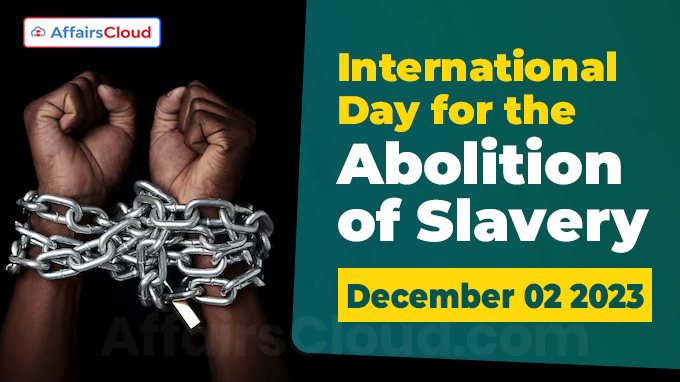 The United Nations (UN) International Day for the Abolition of Slavery is annually observed across the globe on 2 December to combat and eradicate contemporary forms of slavery, such as human trafficking, sexual exploitation, the worst forms of child labour, forced marriage, and the forced recruitment of children for use in armed conflict.
The United Nations (UN) International Day for the Abolition of Slavery is annually observed across the globe on 2 December to combat and eradicate contemporary forms of slavery, such as human trafficking, sexual exploitation, the worst forms of child labour, forced marriage, and the forced recruitment of children for use in armed conflict.
Background:
i.The International Day for the Abolition of Slavery marks the date of the adoption of the UN Convention for the Suppression of the Traffic in Persons and of the Exploitation of the Prostitution of Others (resolution A/RES/317(IV)) by the United Nations General Assembly (UNGA) of 2 December 1949.
ii.The Convention entered into force on 25 July 1951.
50 for Freedom Campaign:
The 50 for Freedom Campaign is led by the International Labour Organization (ILO) and its partners, the International Trade Union Confederation (ITUC) and the International Organization of Employers(IOE).
- The 50 for Freedom campaign is the ILO’s Protocol on Forced Labour that helps millions of children, women, and men reclaim their freedom and dignity.
Modern slavery:
i.Modern slavery serves as an umbrella term, capturing situations where individuals are trapped due to threats, violence, coercion, deception, or abuse of power.
ii.As per ILO’s Global Estimates of Modern Slavery: Forced Labour and Forced Marriage (2022):
- 50 million people were living in modern slavery in 2021. Of these people, 28 million were in forced labour and 22 million were trapped in forced marriage.
- 52% of all forced labour and 25% of forced marriages are reported in upper-middle or high-income countries.
- 86% of all forced labour is imposed by private agents.
Note: Bonded labour is prohibited in India by law vide Articles 21 (Right to Life and Personal Liberty) and 23 (Prohibition of traffic in human beings and forced labour) of the Constitution.
Child Labour:
i.According to the United Nations Children’s Fund (UNICEF), Children worldwide participate in paid and unpaid forms of work.
- In the least developed countries, over 25% of children (ages 5 to 17) engage in labour detrimental to their health and growth.
ii.Child labour, a global concern, is addressed through 3 pivotal international conventions:
- ILO Convention, Minimum Age Convention (No. 138) (1973)
- ILO Convention, Worst Forms of Child Labour Convention (No. 182) (1999)
- UN Convention on the Rights of the Child (UNCRC), 1989.
Human trafficking:
i.The UN Office on Drugs and Crime (UNODC) defines human trafficking as the act of recruiting, transporting, transferring, harbouring, or receiving a person through force, coercion, fraud, or other means of deception.
ii.The UNODC’s 2022 Global Report on Trafficking in Persons shows that:
- 58% of human trafficking convicts in 2020 were male and 1% of convictions involved traffickers aged under 18.
- Eastern Europe and Central Asia continue to convict far more females than males, with 85% of convictions involving women in Central Asia in 2020.




